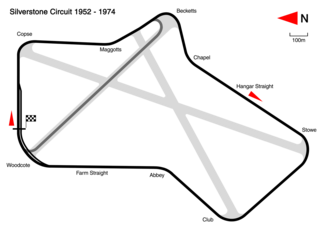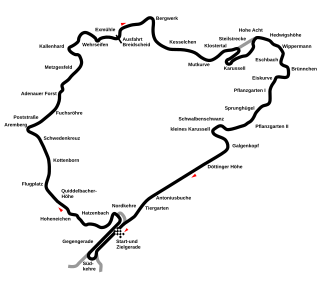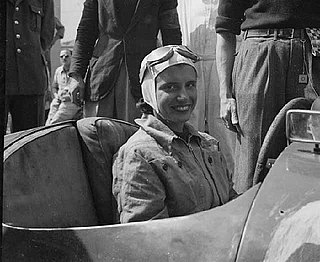
The 1950 Monaco Grand Prix, formally titled the Prix de Monte-Carlo et XIe Grand Prix Automobile, was a Formula One motor race held on 21 May 1950 at Monaco. It was race two of seven in the 1950 World Championship of Drivers. The 100-lap race was held at an overall distance of 318.1 km (197.1 mi) and was won by Juan Manuel Fangio for the Alfa Romeo team after starting from pole position. Alberto Ascari finished second for Ferrari and Louis Chiron finished third for Maserati.

The 1950 Swiss Grand Prix, formally titled the Großer Preis der Schweiz für Automobile, was a Formula One motor race held on 4 June 1950 at Bremgarten. It was race four of seven in the 1950 World Championship of Drivers. The 42-lap race was won by Alfa Romeo driver Nino Farina after he started from second position. His teammate Luigi Fagioli finished second and Talbot-Lago driver Louis Rosier came in third.

The 1950 French Grand Prix was a Formula One motor race held on 2 July 1950 at Reims-Gueux. It was race 6 of 7 in the 1950 World Championship of Drivers. The 64-lap race was won by Alfa Romeo driver Juan Manuel Fangio after he started from pole position. His teammate Luigi Fagioli finished second and Peter Whitehead took third in a privateer Ferrari.

The 1952 Swiss Grand Prix was a Formula Two race held on 18 May 1952 at Bremgarten Circuit. It was the first round of the 1952 World Championship of Drivers, in which each Grand Prix was run to Formula Two rules rather than the Formula One regulations normally used.

The 1952 French Grand Prix was a Formula Two race held on 6 July 1952 at Rouen-Les-Essarts. It was race 4 of 8 in the 1952 World Championship of Drivers, in which each Grand Prix was run to Formula Two rules rather than the Formula One regulations normally used. Unusually this race was run over a duration of 3 hours, rather than a fixed distance.

The 1952 British Grand Prix was a Formula Two race held on 19 July 1952 at Silverstone Circuit. It was race 5 of 8 in the 1952 World Championship of Drivers, in which each Grand Prix was run to Formula Two rules rather than the Formula One regulations normally used.

The 1952 German Grand Prix was a Formula Two race held on 3 August 1952 at the Nürburgring Nordschleife. It was race 6 of 8 in the 1952 World Championship of Drivers, in which each Grand Prix was run to Formula Two rules rather than the Formula One regulations normally used. The 18-lap race was won by Ferrari driver Alberto Ascari after he started from pole position. His teammates Giuseppe Farina and Rudi Fischer finished in second and third places.

The 1952 Dutch Grand Prix was a Formula Two race held on 17 August 1952 at the Circuit Zandvoort. It was race 7 of 8 in the 1952 World Championship of Drivers, in which each Grand Prix was run to Formula Two rules rather than the Formula One regulations normally used. The 90-lap race was won by Ferrari driver Alberto Ascari after he started from pole position. His teammates Giuseppe Farina and Luigi Villoresi finished in second and third places. Ascari overtook Fangio's record for the most race wins, scoring his seventh at this race.

The 1952 Italian Grand Prix was a Formula Two race held on 7 September 1952 at Monza. It was the eighth and final round of the 1952 World Championship of Drivers, in which each Grand Prix was run to Formula Two rules rather than the Formula One regulations normally used. The 80-lap race was won by Ferrari driver Alberto Ascari after he started from pole position. José Froilán González finished second for the Maserati team and Ascari's teammate Luigi Villoresi came in third.

The 1951 Formula One season was the fifth season of FIA Formula One motor racing. It featured the 1951 World Championship of Drivers, which commenced on 27 May 1951 and ended on 28 October after eight races. The season also included 14 races that were open to Formula One cars but did not count towards the championship standings.

The 1950 Formula One season was the fourth season of the FIA's Formula One motor racing. It featured the inaugural FIA World Championship of Drivers which commenced on 13 May and ended on 3 September, as well as a number of non-championship races. The championship consisted of six Grand Prix races, each held in Europe and open to Formula One cars, plus the Indianapolis 500, which was run to AAA National Championship regulations. Giuseppe Farina won the championship from Juan Manuel Fangio and Luigi Fagioli.

Luigi Cristiano Fagioli, nicknamed "the Abruzzi robber", was an Italian motor racing driver. Having won his last race at 53 years old, Fagioli holds the record for the oldest Formula One driver to win a race, and was the only winning Formula One driver born in the 19th century.

Henry O'Reilly "Harry" Schell was an American Grand Prix motor racing driver. He was the first American driver to start a Formula One Grand Prix.

Louis Rosier was a racing driver from France.

Luigi Villoresi was an Italian Grand Prix motor racing driver who continued racing on the Formula One circuit at the time of its inception.
Élie Marcel Bayol was a French racing driver who raced in Formula One for the O.S.C.A. and Gordini teams. Bayol also raced sports cars, mostly driving DB-Panhards for the Deutsch Bonnet works team including winning the 750cc class and Index of Performance at the 1954 24 Hours of Le Mans.

Maria Teresa de Filippis was an Italian racing driver, and the first woman to race in Formula One. She participated in five World Championship Grands Prix, debuting on 18 May 1958, but scored no championship points. Though her Formula One racing career was brief, she won races in other series and is remembered as a pioneer in the sport.
Rob Walker Racing Team was a privateer team in Formula One during the 1950s and 1960s. Founded by Johnnie Walker heir Rob Walker (1917–2002) in 1953, the team became F1's most successful privateer in history, being the first and only entrant to win a World Championship Formula One Grand Prix without ever building their own car.

Ecurie Bonnier, Ecurie Suisse, Joakim Bonnier Racing Team and Anglo-Suisse Racing Team were names used by Swedish racing driver Joakim Bonnier to enter his own cars in Formula One, Formula Two and sports car racing between 1957 and his death in 1972. Commonly the vehicles were entered for Bonnier himself, but he also provided cars for a number of other drivers during the period.















